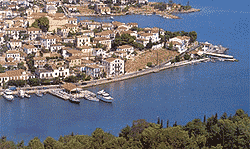 The capital and commercial center of the prefecture is Amfissa (200 km. from Athens), the Byzantine Salona. From the moment you see it, the town will strike you as picturesque, built as it is between the mountains, with its Frankish fortress perched precariously on a precipitous rock and surrounded by olive trees. Here you can see the well-preserved Byzantine church of the Saviour (11th c.), the cathedral of the Annunciation as well as the Phocis Folk Art Museum.
The capital and commercial center of the prefecture is Amfissa (200 km. from Athens), the Byzantine Salona. From the moment you see it, the town will strike you as picturesque, built as it is between the mountains, with its Frankish fortress perched precariously on a precipitous rock and surrounded by olive trees. Here you can see the well-preserved Byzantine church of the Saviour (11th c.), the cathedral of the Annunciation as well as the Phocis Folk Art Museum. Easter in Amfissa is celebrated according to local Roumeli traditions and customs. On Easter Sunday the residents roast lambs and “kokoretsi” in the streets, offering red wine and tasty tidbits to all passers-by. Amfissa is also renowned for its marvellous olives. But what attracts the largest stream of tourists ot the area is nearby Delphi (Delfi), the site of the famous Oracle of Apollo on the slopes of Mt. Parnassos.
The magnificent landscape chosen by the ancient Greeks for their sanctuary, framed by the Phaedriades rocks (the twin “Shining Rocks” that tower above the Oracle) with the Gulf of Itea gleaming in the background, is truly unique.
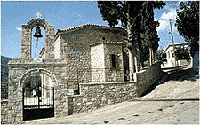 The sanctuary of Athena, the ruins of the temple of Apollo, the Gymnasium, the Stadium – decorated with small statues – the ancient theater, a 4th century BC construction, and the Castalia Fountain are just some of the wonders to admire amidst Delphi’s majestic atmosphere. Finally, don’t miss the museum, which houses the important finds excavated at the site. Among the most impressive are the famous bronze statue of the Charioteer (5th c. BC), the gold and ivory heads of Apollo and Artemis and the Roman copy of the “Navel of the World”.
The sanctuary of Athena, the ruins of the temple of Apollo, the Gymnasium, the Stadium – decorated with small statues – the ancient theater, a 4th century BC construction, and the Castalia Fountain are just some of the wonders to admire amidst Delphi’s majestic atmosphere. Finally, don’t miss the museum, which houses the important finds excavated at the site. Among the most impressive are the famous bronze statue of the Charioteer (5th c. BC), the gold and ivory heads of Apollo and Artemis and the Roman copy of the “Navel of the World”. Delphi is also home to the European Cultural Center, an international organization that sponsors cultural conferences and symposia.
On the road to Itea, it is worth stopping for a while at Chrisso, a charming village filled with plane trees and fountains.
Itea lies at the edge of the Sacred Valley of Delphi. It takes its name from the numerous willow trees (ities) that used to reach as far as the shore. A seaside market town, Itea is slowly evolving into an important commercial and tourist center. It is hard to pass by the nearby beaches of Trocadero and Miami, or the beach of Itea, without taking a dip.
Very close to Itea is the village of Kira, the flourishing port of Delphi in antiquity. Nowadays its long stretch of beach attracts many bathers.
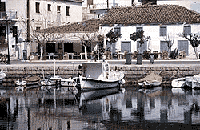 Following the coast road west of Itea, you come to Galaxidi. Situated at the end of a little fjord, it was an important naval and shipbuilding center until 1821 when it was destroyed. In this pleasant harbour, tradition is still very evident along the quay amongst the seafood tavernas and boat yards, where selftaught craftsmen still make sturdy wooden caiques. It is well worth strolling through the picturesque streets lined by stately mansions and dotted with little tavernas drenched in geraniums and jasmine. Don’t miss the Galaxidi Archaeological and Naval Museum, with its fine exhibits of model ships, maps, naive sea paintings and weapons from the War of Independence; the church of St. Nicholas, famous for its carved wooden icon screen; and Aghia Paraskevi, which has the zodiac cycle inlaid in its floor and a sundial in its forecourt. If you happen to be in Galaxidi on Clean Monday (beginning of Lent), you’ll get caught up in the revels of the masqueraders who throw flour at each other in festivities with heavy Dionysiac overtones.
Following the coast road west of Itea, you come to Galaxidi. Situated at the end of a little fjord, it was an important naval and shipbuilding center until 1821 when it was destroyed. In this pleasant harbour, tradition is still very evident along the quay amongst the seafood tavernas and boat yards, where selftaught craftsmen still make sturdy wooden caiques. It is well worth strolling through the picturesque streets lined by stately mansions and dotted with little tavernas drenched in geraniums and jasmine. Don’t miss the Galaxidi Archaeological and Naval Museum, with its fine exhibits of model ships, maps, naive sea paintings and weapons from the War of Independence; the church of St. Nicholas, famous for its carved wooden icon screen; and Aghia Paraskevi, which has the zodiac cycle inlaid in its floor and a sundial in its forecourt. If you happen to be in Galaxidi on Clean Monday (beginning of Lent), you’ll get caught up in the revels of the masqueraders who throw flour at each other in festivities with heavy Dionysiac overtones. Another charming fishing village west of Galaxidi is Eratini. Nearby is the site of ancient Tolophon.
Continuing west, the seaside settlements of Aghios Nikolaos, Spilia and Glifada, as well as the islands of Trizonia, Aghios Ioannis and Prassoudi opposite are ideal for bathing and fishing. If you’re seeking peace and quiet, we suggest you visit the mountain villages of Eptalofos or Ano Agoriani, a starting point for the Parnassos ski center, Lilea, Polidrossos and Gravia surrounded by fir trees and streams. At Aghia Efthimia near Amfissa, the delicious wine will help you to forget your worries. West of Amfissa lies the interesting monastery of the Panayia Koutsoufou in the village of Amigdalia, while somewhat cut off from the rest of the prefecture is Lidoriki, a town on the slopes of Mt. Giona, not far from the Mornos dam and reservoir.
Delphi
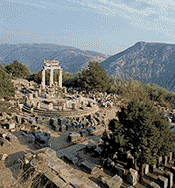 The Delphi Museum contains the superb statue of the Charioteer, circa 475 BC. The Sanctuary of Apollo in Delphi had been one of the most glorious oracles in antiquity, along with these of Zeus in Olympia and of Apollo in Delos. It is situated on the slope of Mount Parnassus, above the valley of Plisto. It was built during the archaic period to host the cult of the snake Python, son of Mother Earth. The place took its contemporary name from the cult of Apollo Delphinios, i.e. the god worshipped in the shape of a dolphin. Only very few elements of this cult survived. Even the priestess who delivered the oracles preserved the ancient name Pythia, whereas later she was also referred to as Sibyl. The sanctuary soon gained political importance, as it became the seat of one of the mightiest amphictyoniae, or holy alliances, and an essential reference point for all the Greek cities wishing to establish colonies on western Europe. It was honoured even by Kroisos, the extremely rich king of Lydia, as well as by the Pharaoh of Egypt, Amasis. The sanctuary has been the cause of many sacred wars for its control, but its prestige remained intact. When in 373 BC it suffered serious damages by an earthquake, many city-states collaborated in order to restore it. During the Roman period it was honoured by the first Roman leaders and later by emperors such as Augustus, Nero and Hadrian. Gradually, however, it fell in decline. In 385 AD Theodosius outlawed paganism and forbade the existence of oracles. Since then, "the voice of the water faded away", as its last priests allegedly have said. In contemporary times, the excavations at the archaeological site began in 1892 by a group of French archaeologists and are still under way.
The Delphi Museum contains the superb statue of the Charioteer, circa 475 BC. The Sanctuary of Apollo in Delphi had been one of the most glorious oracles in antiquity, along with these of Zeus in Olympia and of Apollo in Delos. It is situated on the slope of Mount Parnassus, above the valley of Plisto. It was built during the archaic period to host the cult of the snake Python, son of Mother Earth. The place took its contemporary name from the cult of Apollo Delphinios, i.e. the god worshipped in the shape of a dolphin. Only very few elements of this cult survived. Even the priestess who delivered the oracles preserved the ancient name Pythia, whereas later she was also referred to as Sibyl. The sanctuary soon gained political importance, as it became the seat of one of the mightiest amphictyoniae, or holy alliances, and an essential reference point for all the Greek cities wishing to establish colonies on western Europe. It was honoured even by Kroisos, the extremely rich king of Lydia, as well as by the Pharaoh of Egypt, Amasis. The sanctuary has been the cause of many sacred wars for its control, but its prestige remained intact. When in 373 BC it suffered serious damages by an earthquake, many city-states collaborated in order to restore it. During the Roman period it was honoured by the first Roman leaders and later by emperors such as Augustus, Nero and Hadrian. Gradually, however, it fell in decline. In 385 AD Theodosius outlawed paganism and forbade the existence of oracles. Since then, "the voice of the water faded away", as its last priests allegedly have said. In contemporary times, the excavations at the archaeological site began in 1892 by a group of French archaeologists and are still under way. 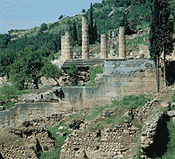 The Temple of Apollo: The Sacred Way runs along the protective wall of the platform of the Temple of Apollo, which in the ancient times covered an Ionic row of columns made of Parian marble, financed by the Athenians after the Persian wars had ended. It is a petipteral temple of Doric order, 60.32 x 23.82 meters, with poros stone pillars plated with marblestone, 6 on the small sides and 15 on the large ones. The cella had two pillars, both on the porch as well as on the opisthodrome, whereas inside there was the adyton, the most sacred of all spaces that no one could enter, since it contained the omphalos, the centre of the world. The pillars architraves were adorned with the shields of Persians from the battle at Plataeae and of the Gauls of the third century BC. The roof was covered with marble tiles. It is believed that there was an underground space where only the pythian soothsayer could enter, in order to obtain the oracles from the gods. The side of the platform close to the mountain, on the temple's right side, suffered serious landslides. During one of them, probably in 373 BC, the bronze chariot dedicated in 474 BC by the tyrant of Syracuse Polyzalos was buried. The statue of the Charioteer, in natural dimensions, is one of the most famous masterpieces of archaic art and was brought to light during excavations; today, it adorns the Delphi Museum.
The Temple of Apollo: The Sacred Way runs along the protective wall of the platform of the Temple of Apollo, which in the ancient times covered an Ionic row of columns made of Parian marble, financed by the Athenians after the Persian wars had ended. It is a petipteral temple of Doric order, 60.32 x 23.82 meters, with poros stone pillars plated with marblestone, 6 on the small sides and 15 on the large ones. The cella had two pillars, both on the porch as well as on the opisthodrome, whereas inside there was the adyton, the most sacred of all spaces that no one could enter, since it contained the omphalos, the centre of the world. The pillars architraves were adorned with the shields of Persians from the battle at Plataeae and of the Gauls of the third century BC. The roof was covered with marble tiles. It is believed that there was an underground space where only the pythian soothsayer could enter, in order to obtain the oracles from the gods. The side of the platform close to the mountain, on the temple's right side, suffered serious landslides. During one of them, probably in 373 BC, the bronze chariot dedicated in 474 BC by the tyrant of Syracuse Polyzalos was buried. The statue of the Charioteer, in natural dimensions, is one of the most famous masterpieces of archaic art and was brought to light during excavations; today, it adorns the Delphi Museum.
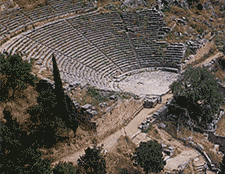 The Theatre: A small scale connected this platform with the theatre, which was built in the fourth century BC and was restored during the Hellenistic and the Roman period. A terrace wall called Ischegaon from the verb ischo which means "to retain the earth" supported the cavea on the hillside. The cavea consisted of 35 rows of seats and had a capacity of 5000 spectators. One can still see the cobblestone orchestra and the foundations of the stage, adorned with a marble frieze depicting the Labours of Hercules, today kept in the Museum. Above the sacred yard a clear path leads to a small valley where the stadium is. A part of it was built during the fifth century BC, but it was subsequently restored several times. On the north side, towards the mountain, there are 12 rows of columns carved in the rock. On the opposite side, another 6 rows stand upon earlier foundations. In this stadium there took place every four years the Pythian Games, which included musical and theatrical competitions, held at the theatre, as well as chariot races, held at the valley. In 528, right after the sacred war, the Pythian Games were reorganized with a new set of rules. Thereafter, they took place more often and went on until the end of antiquity.
The Theatre: A small scale connected this platform with the theatre, which was built in the fourth century BC and was restored during the Hellenistic and the Roman period. A terrace wall called Ischegaon from the verb ischo which means "to retain the earth" supported the cavea on the hillside. The cavea consisted of 35 rows of seats and had a capacity of 5000 spectators. One can still see the cobblestone orchestra and the foundations of the stage, adorned with a marble frieze depicting the Labours of Hercules, today kept in the Museum. Above the sacred yard a clear path leads to a small valley where the stadium is. A part of it was built during the fifth century BC, but it was subsequently restored several times. On the north side, towards the mountain, there are 12 rows of columns carved in the rock. On the opposite side, another 6 rows stand upon earlier foundations. In this stadium there took place every four years the Pythian Games, which included musical and theatrical competitions, held at the theatre, as well as chariot races, held at the valley. In 528, right after the sacred war, the Pythian Games were reorganized with a new set of rules. Thereafter, they took place more often and went on until the end of antiquity.
Galaxidi
During the period of the secret movement of Filiki Society, the marines from Galaxidi were in constant contact through the
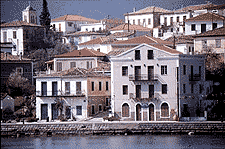 Patriarch Gregorios the 5th with the Archibishop of Salona Essaias who was a member of the Filiki Society. Because of the freedom to travel in the seas of Ionian and Aegean and in Efxinos and the Mediterranean the city of Galaxidi became quite rich, and civilized with autonomous government and privileged taxation.It had a harbour and 40 big ships, a lot of smaller ones and land force.
Patriarch Gregorios the 5th with the Archibishop of Salona Essaias who was a member of the Filiki Society. Because of the freedom to travel in the seas of Ionian and Aegean and in Efxinos and the Mediterranean the city of Galaxidi became quite rich, and civilized with autonomous government and privileged taxation.It had a harbour and 40 big ships, a lot of smaller ones and land force.The privileged situation of Galaxidi was mainly because of:
The nautical growth of the city and the special nautical abilities of its people who came in contact with all the known world.
The special attachment and favor of the first Soultana (Valide Hanoum) to whom the captains of Galaxidi were offering gifts in every passage from Constantinopole.
The friendship and protection of Ali Pasha of Ioannina who had in his court a lot of captains from Galaxidi.
The reasons which influenced the people of Galaxidi to contribute to the liberation war of 1821 were national,moral and psychological. They first joined forces with people from other cities of Roumeli in Messologgi and later in Hydra.On March 26, 1821 they declared the start of the war (about 1400 men) with Ioannis Metropoulos as their leader in the location of the present church of Saint John Prodromos. In the neighboring city of Saint Efthymia they joined forces with Panourgias and his men and moved to Salona in order to liberate its castle. Among them was Ioannis Karalivanos and on the 10th of April 1821 the castle was conquered by this group of fighters from Galaxidi as well as the whole historic city of Salona. It was the first turkish fort which fell in the hands of Greeks.
 They moved on to Alamana and Gravia having the Archibishop Essaias with them. On the bridge of Alamana the legendary hero Athanassios Diakos was caught by the Turks and later on brutally killed.The remaining 117 people were locked in the Hani of Gravia with Odysseus Androutsos. Among them, 52 were from Galaxidi according to the historian Sathas.Everybody fought with pride until the end.
They moved on to Alamana and Gravia having the Archibishop Essaias with them. On the bridge of Alamana the legendary hero Athanassios Diakos was caught by the Turks and later on brutally killed.The remaining 117 people were locked in the Hani of Gravia with Odysseus Androutsos. Among them, 52 were from Galaxidi according to the historian Sathas.Everybody fought with pride until the end.The people of Galaxidi went on to Nafpaktos which they surrounded. But personal interests and passions among the rulers caused the murder of Ioannis Metropoulos at the age of 41 in his sleep.His death not only created a lot of sorrow among his followers, but also was the cause of their leaving the city of Nafpaktos. The Turks then took advantage and burned the city and all the ships.
Galaxidi as a marine center had also started the war in the sea.In their ships, captains from Galaxidi raised the local liberation flag in black and white showing the eagle (Greek nation) attacking the dragon (Ottoman empire). With all their fleet they left the harbour with destination to Nafpaktos and Patra to cut off the connectivity of Turks from Roumeli and Peloponnese.
The contribution of Galaxidi from land and sea during the liberation war was the cause of the decline of the city which sacrificed itself during that holy war of the nation.
The cultural contributon of Galaxidi was big as well. Among the three big newspapers in Roumeli was that of Galaxidi.The other two were the Aitoliki of Messologgi and Acheloos of Agrinio.
The people of Galaxidi continued their fight by organizing a small fleet before the fleets of Hydra and Spetses come to existence.The leader was Constantin Dedousis. Later on the joined fleets of Hydra, Galaxidi and Spetses surrounded from the sea the city of Nafpaktos and prevented the contact of the Turks from the sea. The ships of Hydra and Spetses at some point left and the fleet of Galaxidi remained to continue with Agamemnon, the ship of Bouboulina, which left as well after a while for Spetses. The Turks then decided that it was time to get rid of Galaxidi since it was a major threat in the area of Corinthia-Nafpaktos-Patra. The Turk-egyptian fleet with the Egyptian Ismael Gibraltar as their leader left the harbour of Patra and went to Galaxidi on September 22, 1821.
 Most of the ships of Galaxidi were out in the seas offering their services to the liberation war.Galaxidi had been left without defence with only few men who fought heroically until the end.The city which had cultivated and taught the highest virtues of honesty,dignity with its heritage and riches was burned and destroyed in one day.
Most of the ships of Galaxidi were out in the seas offering their services to the liberation war.Galaxidi had been left without defence with only few men who fought heroically until the end.The city which had cultivated and taught the highest virtues of honesty,dignity with its heritage and riches was burned and destroyed in one day.However,after a few months of its destruction Galaxidi managed to rebuild its shipyards and made its comeback as fighters in the Corinthian sea against the Turks.
In the land now,organized troops of Kioutachis came on to Messologgi destroying everything which came in their way.They passed by Galaxidi and Salona. Again Imbraem left Patra and came to the sea of Galaxidi.This time the inhabitants had time to leave the city and Imbraem only captured 30 small ships.
The third time the scheme of the Turks succeded and Galaxidi was completely destroyed.
Many historians (mainly from Peloponnese) hid the historical facts about Galaxidi and presented only those about Peloponnese. In the national archives there are two documents from Galaxidi which describe the action of the historic city of Galaxidi. After the liberation of the new Greek state, a commitee of nautical people was formed with Andreas Miaoulis as president.This commitee decided to honor the marine warriors of 1821. Among them were 11 from Galaxidi.
In 1860, Galaxidi managed to have its shipyards in operation again and, at the same time, they formed 3 nautical insurance companies with founders and members responsible to pay in case of a ship damage of another member depending on the proportion of contribution which was based on the ship's value.
It was an ideal insurance which even astonished the greater at the time insurance company:LLoyd's.
In 1892 the growth reaches its height with 550 ships sailing in the seas and continuing Galaxidi's nautical presence. Those 550 ships were mainly owned by the families of Levantis, Kammenos, Petradzas, Chardavellas, Metropoulos and Vlamis.
However during the last decade of the 19th century the Galaxidi fleet starts falling behind. Steam replaces sails but the Galaxidi fleet does not follow.
Galaxidi is considered the second nautical center after Syros.It had a school of captains which was in operation before those of Hydra and Aspropyrgos.

